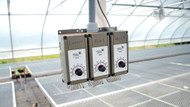Save Valuable Time and Money
If you are still controlling your greenhouse environment with thermostats, or even manually, energy prices warrant that these days must come to a close. Although the initial cost of a thermostat is very low, the increased cost to have a thermostat operating your greenhouse equipment will astound you. Using a computer control system will save you valuable time and money in the long run.
The control system that you choose does not have to be an expensive and complicated computer system. There are many products on the market starting at under $1,000 that will let you control your heating and cooling costs very well. The new digital controls include separate day and night settings for heating and cooling, high and low temperature readings, and many other useful energy-saving features. The payback of installing a digital environmental control can be realized in just a couple of months, depending on the size of your range.
How does a greenhouse computer control the greenhouse?
The word computer can be very intimidating. Actually, “a computer” really refers to a small microprocessor chip no larger than the width of your two fingers. Like virtually all industries that use control methods, the microprocessor allows the control to monitor many sensors at one time and make “intelligent” decisions on what to do and when to do it.
What should the grower look for?
The grower should look for the features that they need, the reliability that is a must, and a price that they can afford. If a grower does not have the time and the manpower to devote to a large, complicated system, then a small system would be in order. Some companies will stress the need for a major, all-inclusive system, but the reality is that all growers are not ready for these. It is not necessary to spend tens of thousands of dollars in order to have reliable, efficient, computer-based control. If a grower is just converting over from a thermostat or a manual system, they should start slow—do one range, try it out, and then proceed.
How can the investment pay off?
The major payoff will be in energy savings. Simply overheating a greenhouse by a single degree can cost thousands of dollars in wasted energy. With some of the algorithms available, we can adjust temperatures based on solar gain, outdoor temperature, time of day, energy demand period and other factors. For instance, on a hot water system, why fire the boiler to a very high temperature on a fairly mild evening? This investment can also pay off in the reduction of labor costs. Obviously, having a reliable machine performing these tasks instead of a compensated employee is also a plus.
What happens when the power goes out?
When the power goes out, nothing will work unless there is a generator. Almost all of the major control systems use a memory backup, which stores all of the grower settings and the operational system in something called an EEPROM. This memory is not dependent on power or even on a battery. When the power comes back on and proves that it is stable, everything returns to a normal start-up mode and the grower settings can be quickly restored.

